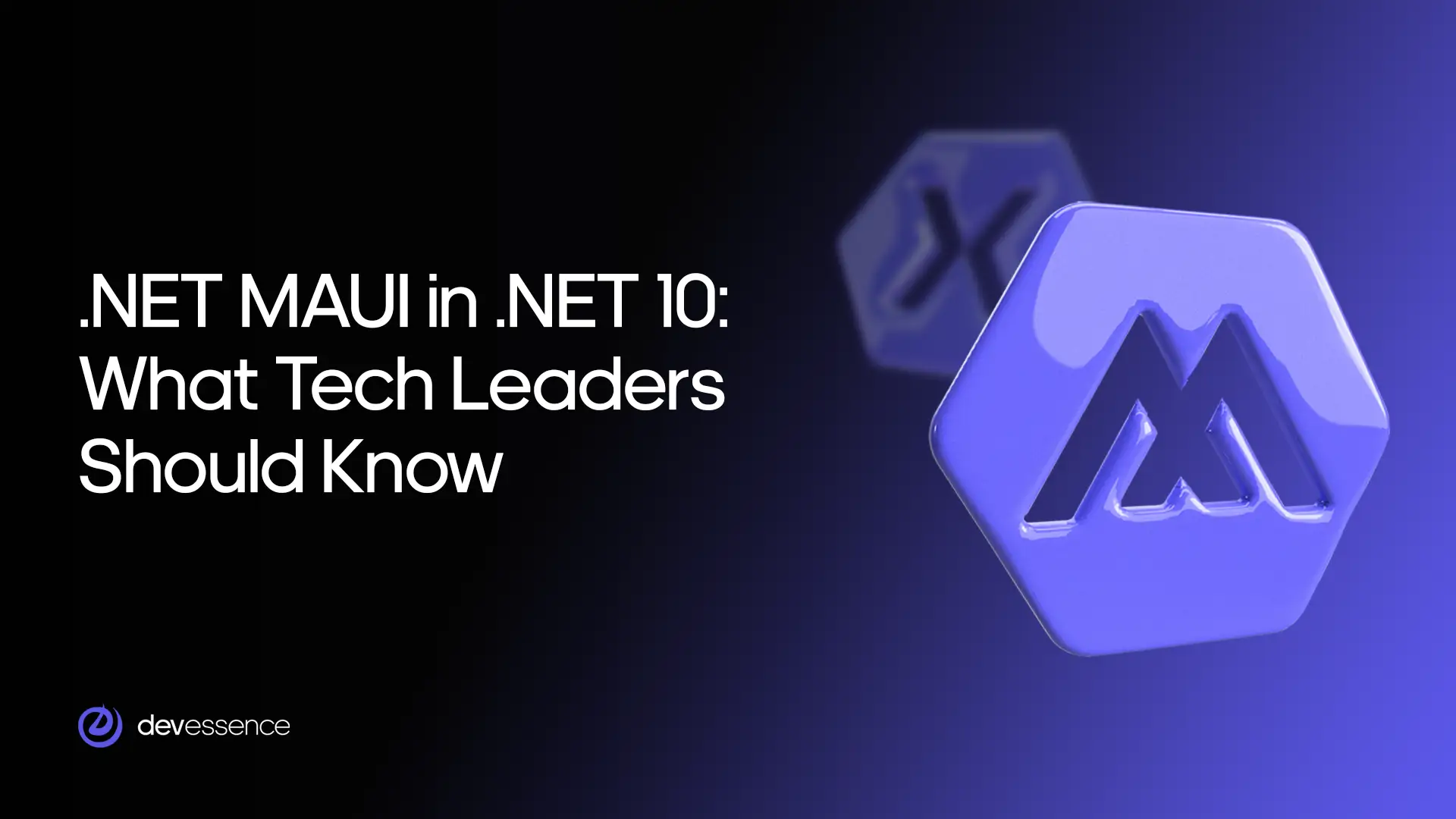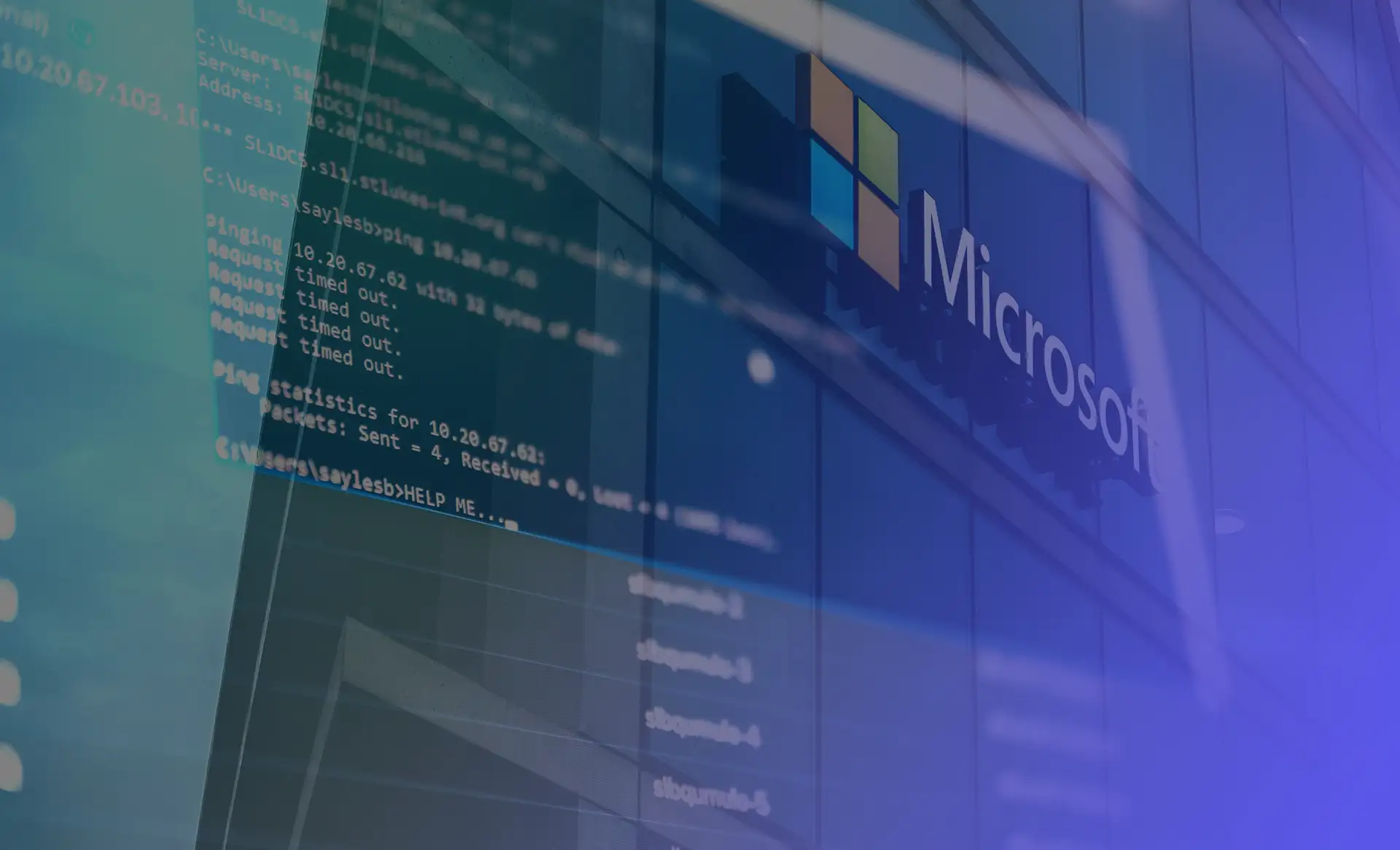.NET MAUI 10 Explained: Why Tech Leaders Should Care About Microsoft’s Latest Cross-Platform Update
10/30/2025
By: Devessence Inc

As a tech leder, you, probably, need both speed and quality, and you need it across every device their users touch. Microsoft’s .NET MAUI 10 release makes that balance achievable. it gives companies a unified way to build and maintain applications for mobile, desktop, and cloud environments without duplicating effort.
This update focuses on what matters most to engineering and product teams: better performance, smoother integrations, and fewer platform inconsistencies. It’s a practical framework for organizations already invested in .NET, designed to help teams ship updates faster, reduce maintenance costs, and extend existing systems to new platforms.
In our new article, we’ll look at:
– The most important upgrades in .NET MAUI 10.By the end, you’ll understand how .NET MAUI 10 can simplify development, strengthen your software ecosystem, and prepare your organization for what’s next.
Key Improvements in .NET MAUI 10
For tech leaders in general, .NET MAUI 10 updates mean less time managing issues and more time delivering value. Here is precisely why.
Better performance and stability
The latest MAUI release introduces optimized memory usage and smoother UI rendering, especially for data-heavy applications. Apps now start faster, respond quicker, and stay stable even under high workloads. This is a crucial gain for customer-facing and enterprise solutions.
Faster development and debugging
Development teams can iterate rapidly without long build cycles thanks to improved hot reload reliability, updated toolchains, and enhanced diagnostics. This leads to shorter release timelines and more predictable delivery for your stakeholders.
Easier integration with cloud tools like .NET Aspire
MAUI 10 connects seamlessly with .NET Aspire, so it becomes simpler to build cloud-native apps with built-in observability, configuration, and deployment pipelines.
You can unify your mobile and cloud strategies under one ecosystem. It reduces integration risks and operational overhead.
More consistent user experience across devices
MAUI 10 ensures greater visual and behavioral consistency across Android, iOS, macOS, and Windows. This means your users get a unified experience, and your teams spend less time fixing platform-specific issues.
Why It Matters for Business
First and foremost, you can build once, run anywhere. It saves time and costs.
MAUI 10 lets your team maintain a single codebase that works across Android, iOS, Windows, and macOS. This reduces development and testing efforts, lowers maintenance costs, and allows your resources to focus on delivering value rather than rewriting code for each platform.
Faster delivery of updates and features
Improved tooling and more reliable hot reload make it easier for developers to implement changes quickly. Development teams can release updates and new features faster, keeping users engaged and staying ahead of competitors.
Easier to maintain and scale existing .NET apps
MAUI 10 integrates smoothly with existing .NET applications. It supports code reuse and works well with the current infrastructure, simplifying upgrades and expansions while minimizing disruption.
Reliable, future-ready framework for long-term growth
With Microsoft’s continuous support and a growing ecosystem of tools, MAUI 10 provides a stable foundation for building scalable and maintainable applications. It prepares your digital products for evolving business needs without requiring constant rework.
Check our Blazor & .NET MAUI Consulting Services
Read more3 Real-World Scenarios for Decision-Makers
There are three typical scenarion where you can use .NET MAUI 10 in practice.
To rebuild outdated apps
Many organizations still rely on legacy Xamarin or native apps that are slow to update and costly to maintain. Migrating to .NET MAUI 10 lets you consolidate multiple codebases into a single, modern framework.
As teh result, your apps can perform better, crash less, and are easier for developers to iterate on. This is especially valuable for enterprise apps with complex workflows or high user volumes, where stability and speed directly affect productivity and satisfaction.
To extend internal systems to mobile
Remote and hybrid work becomes the norm. Companies of different industries consider giving employees access to internal tools on mobile devices.
.NET MAUI 10 allows you to extend existing desktop or web applications to smartphones and tablets without rebuilding everything from scratch. Teams can access dashboards, reports, or operational tools on the go, boosting efficiency and ensuring critical business processes stay uninterrupted.
To create customer-facing apps with consistent UX
Uniform experience across platforms is essential for modern businesses. MAUI 10 ensures that your apps look and behave consistently on iOS, Android, Windows, and macOS.
Real-world examples include retail dashboard apps that give managers real-time inventory insights, telehealth portals that let patients book appointments and access medical records, or logistics tracking tools that provide live updates to customers and staff. Consistency reduces user friction and strengthens brand trust.
Read also: .NET MAUI and .NET 10 for Cross-Platform EdTech Apps
Risk Mitigation with MAUI 10
MAUI 10 allows you to modernize apps incrementally, so critical systems stay operational while updates are rolled out. This ensures business continuity and avoids disruptions for employees and customers.
Also, a single, unified codebase reduces inconsistencies across platforms. MAUI 10 helps prevent the common bugs and glitches that appear when maintaining separate Android, iOS, and Windows apps, resulting in a smoother user experience.
Finally, MAUI 10 works seamlessly with your current .NET code and enterprise infrastructure. This reduces integration risks, preserves existing functionality, and allows teams to leverage familiar libraries and frameworks without rewriting core components.
When to Consider Moving to .NET MAUI 10
If you’re not sure about moving, here's the main reason to do this.
You’re still using Xamarin or older .NET versions
Older frameworks can slow development, introduce maintenance challenges, and limit device compatibility. MAUI 10 unifies these platforms under a single, modern framework, improving performance and reducing complexity while giving developers a familiar .NET environment.
You plan to expand to mobile or desktop
Reaching users across devices shouldn’t mean rewriting apps multiple times. MAUI 10 allows a single codebase to run on Android, iOS, Windows, and macOS. This makes it faster to launch new platforms, maintain feature parity, and deliver consistent user experiences.
You want to modernize legacy systems
Modernizingmust focus on business efficiency. MAUI 10 lets you upgrade existing .NET apps while reusing code, minimizing downtime, and reducing the risk of costly errors. The result is apps that perform better, scale easily, and support long-term growth.
Strategic timing
The timing of your migration can determine how smoothly the transition goes, how much value you extract from modernization, and how well your business adapts to new demands. Below are the key scenarios when making the move delivers the greatest impact.
Align with major updates
When your team is planning a significant release, adopting .NET MAUI 10 allows you to modernize and enhance features at the same time. This approach reduces duplicated effort, ensures consistency across platforms, and accelerates delivery of new capabilities.
Migrate before legacy systems end-of-life
Older Xamarin or .NET versions may soon lose support or security updates. Moving to MAUI 10 ahead of time mitigates risks such as downtime, compliance issues, and costly emergency fixes. It ensures your applications remain secure, stable, and future-ready.
Expand your digital footprint efficiently
If your business is adding mobile or desktop access, entering new markets, or reaching a wider audience, MAUI 10 makes scaling simpler. A single codebase can target Android, iOS, Windows, and macOS, providing a consistent user experience while saving development time and cost.
Optimize resources and ROI
Strategic migration timing lets you maximize existing development resources and minimize disruption. By combining modernization with planned updates or expansion, you improve ROI and accelerate the benefits of cross-platform development.
Read also: Cross-Platform Development with .NET MAUI: Features and Benefits
How We Can Help
At Devessence, we help companies make the most of .NET MAUI 10 by combining technical excellence with strategic insight. Here’s how our team supports your migration every step of the way.
Assess and plan
We evaluate your current systems and build a clear migration roadmap. This helps you understand the effort, timeline, and ROI before starting any project.
Modernize with minimal risk
Our team modernizes apps while keeping downtime and disruption to a minimum. You get a smooth transition that protects business continuity and user experience.
Optimize performance across platforms
We ensure your applications deliver top performance on every device. From mobile to desktop, users enjoy seamless, consistent experiences.
Scale your team with experts
Devessence provides experienced engineers and security specialists to complement your in-house team. This accelerates development while maintaining high standards for security and quality.
Apply cross-industry insights
Our work spans multiple industries, giving us a broad perspective on best practices, challenges, and solutions. We bring lessons learned from diverse projects to deliver better results faster.
Final Thoughts
Microsoft’s continue to focus on cross-platform innovation, and .NET MAUI 10 stands out as a solid foundation for future-ready enterprise applications. It delivers measurable gains in speed, reliability, and developer productivity while offering tighter integration with Azure and .NET Aspire.
Analysts forecast that more enterprise mobile and desktop apps will be powered by shared frameworks. In this context, MAUI 10 is a smart, sustainable choice for organizations planning long-term growth.
For companies still running on Xamarin or legacy .NET versions, migration is critical to reduce operational risks and improve time-to-market. MAUI 10 simplifies this shift with better tooling, compatibility, and code reuse, allowing teams to evolve existing systems without starting from scratch.
Businesses embracing MAUI 10 early are already seeing tangible benefits: reduced maintenance overhead, unified design standards across platforms, and shorter release cycles. These advantages compound over time, turning technical modernization into a clear business differentiator.
At Devessence, we help you make that transition strategically. Our experts guide you through every step, from assessing your current systems to deploying high-performance, cross-platform applications that scale with your business.
Modernization starts with the right partner. Contact Devessence to discuss your .NET MAUI 10 migration and unlock the full potential of your development ecosystem.
Contact usFAQs
-
Is .NET MAUI mature enough now?
Microsoft has shifted its focus toward stability and enterprise adoption. MAUI 10 benefits from years of improvements under Xamarin and .NET, making it reliable for production apps. Many early adopters report smoother performance, fewer crashes, and faster iteration cycles.
-
What about migration cost?
You can reuse a large portion of your existing .NET code, which reduces development effort and speeds up ROI. Instead of starting from scratch, MAUI 10 allows you to modernize apps efficiently while minimizing disruption to ongoing projects.
-
How does this compare to Flutter or React Native?
If your organization is already invested in the .NET ecosystem, MAUI 10 is often the more seamless choice. It integrates naturally with existing tools, libraries, and workflows, reducing overhead compared with adopting an entirely new technology stack.
-
Will I need to retrain developers?
MAUI 10 uses familiar C# and XAML, so your current .NET developers can adapt quickly. This reduces the learning curve and ensures teams remain productive while adopting the new framework.
-
Will it integrate with our existing infrastructure?
Yes. .NET MAUI 10 is built to work smoothly with your current .NET ecosystem, Azure services, and enterprise tools. You can connect existing APIs, authentication systems, and CI/CD pipelines without major refactoring. This compatibility reduces integration risks and shortens the time from migration planning to production deployment.
